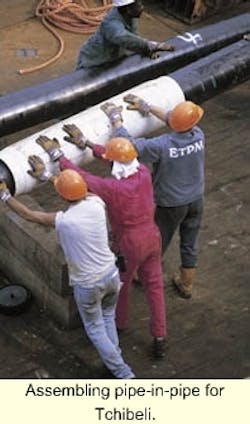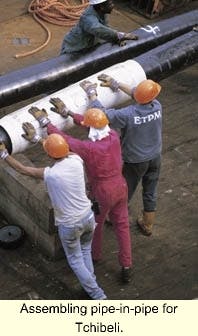Reducing complexity of pipe-in-pipe improves assembly, insulation qualities
Highly insulated pipelines have historically been complex pieces of fabrication and engineering, requiring many man-hours of work per joint. The work is mostly welding, of course, but also includes periods for lifting and moving the joints around, plus time spent waiting for a pipe that hasn't been moved into place, either because the lifting equipment is not available or because the previous workstation has not yet finished.
Total Oil Marine's Dunbar multiphase pipeline, installed in 1993, was the first double-walled, thermally insulated pipeline to be laid in the North Sea. It represented a breakthrough over previous thermally insulated designs as a U-value of 1.2 W/(m2K) was achieved - a factor of 3-4 over what was considered practical at that time.
However, this system, although performing up to specifications, was complex, consisting of two threaded connectors and two tulips for each double joint. Onshore fabrication of each double joint required 10 welds. Furthermore, each insertion demanded the use of three spacers to ensure proper centering of the two pipes and to protect the glass fiber insulation from compression.
Although the principle of the Dunbar pipe was sound, the design had to be simplified to drive down costs. Three avenues for doing this were identified:
- Reducing the overall diameter of the assemblies
- Diminishing the number of separate elements
- Reducing the amount of onshore fabrication welding.
To address these issues, ITP in Louveciennes, France developed the "Ultimate" system. A first production prototype was built in summer 1998. A contract for 25 km of this pipe was awarded by Elf early in 1999 for the tieback of the Tchibeli Field offshore Congo to the Nkossa production barge. Laying of the pipe was completed in February of this year.
Insulation design
Classical insulating materials draw their efficiency from their opacity to (infra-red) radiation and their cellular structure, which enables them to capture air or any other thermally efficient gas, in order to prevent it from forming convection cells. This way, thermal conductivity somewhat higher than that of the still gas can be attained. The only way to improve thermal efficiency further is to reduce the gaseous conduction, in two ways:
- Drawing a deep vacuum in the annulus to eliminate the gas molecules entirely
- Implementing a material with a cell size smaller than the mean free path of the gas molecules, thereby hindering them from exchanging energy.
This latter method was deem ed more feasible as industrial materials with small-cell structures already existed. ITP, together with a UK-based insulation specialist, therefore developed Izoflex, a patented material designed specifically for pipeline insulation. This was subsequently qualified on Shell UK's ETAP development.
Izoflex has been proven to out-perform conventional insulation materials on industrially fabricated pipes by a factor of 3-10. Further advantages are its resistance to high temperature/high pressure (HT/HP) environments, to compression (allowing it to withstand high laying loads and hydrostatic pressure), and to vibrations.
The pipe's outer diameter can be reduced because of the more efficient insulation material. For the Tchibe* installation, in a 10/12-in. pipe, 15 mm of insulation yields a U-value of better than 0.5 W/(m2K) in the mainline section. The overall U-value normally will depend on the field jointing.
A further advantage of the close fit between outer and inner pipes is that it has allowed the elimination of add-on pieces. ITP has developed a proprietary fabrication process that introduces a plastic deformation of the outer pipe, and also allows welding directly onto the inner pipe. Furthermore, as Isoflex resists compression loads, there is no need for spacers - the material itself aligns the two pipes.
Once the outer pipe is swaged onto the inner pipe, the two pipes are linked with a full penetration girth weld. Thus, only two welds are needed to complete a single joint. A further advantage is that the weld is located on the inner pipe, which increases the pipe's fatigue resistance, or conversely allows it to accept higher curvatures for the same level of stress at the weld, as compared with a design where the weld is located on the outer pipe diameter.
Isoflex's mechanical strength allows the outer pipe to be considered as a watertight barrier with a limited structural role. This allows its thickness to be somewhat reduced, in turn cutting overall costs and rendering the pipe lighter. Also, the material's inherently adjustable thermal conductivity, through controlling the annulus, confers a high degree of flexibility on the system, allowing the final decision on the U-value to be delayed until the actual fabrication process starts, while keeping the same overall pipe diameters and system mechanical strength. The U-value can be adjusted by a factor of two to three at minimal extra cost.
Tchibeli
The system was recently proposed and qualified for Elf's Tchibelif project offshore Congo. Due to the system's simplicity - only six workstations are required - ITP could set up its fabrication line directly in the onshore pipe coating shop. This brought significant logistical savings for the project, as the 2,100 modules were completed on time in less than three months, six weeks ahead of schedule. As fabrication gathered pace, up to 72 modules were completed every day.
As part of its quality plan, ITP conducted regular quality checks to ensure that thermal requirements were being met. Altogether, 4% of all tubes were tested, with an average U-value of 0.55/W(m2K) being obtained, including the field joint effect, which was far better than the 0.8W(m2K) specified. The field jointing system developed for a double-walled system must satisfy three requirements:
- Should secure the mechanical continuity at the field joint, otherwise the local reduction in flexural rigidity will lead to localization of the strain at this point and therefore unacceptable stress levels
- Should be sufficiently well insulated so that both overall average thermal requirements are respected and to ensure that systematic cold points do not arise, in turn leading to preferential deposition of waxes in operation or rapid formation of hydrates during slowdowns
- System must be adapted to lay barges (capable of installation times compatible with barge cycle times down to five minutes).
ITP has also developed a technique to comply with these requirements. This is based on the use of a steel sleeve (providing the necessary flexural inertia) blocked by a fast-setting resin or polymer that locks the sleeve and pipes together in an arrangement that secures the mechanical continuity.
For the Ultimate design, ITP developed a more cost-effective principle based on a smooth sleeve injected with resin. To limit heat losses at the field joint, the sleeve is insulated in its own right. Impact of the sleeve on the overall U-value can thus be limited to 0.05-0.15W/(m2K).
This field jointing system was implemented on Tchibeli, with the offshore field jointing performed under ITP's management. The green light for moving the pipelay barge was given consistently in under five minutes. Resin setting times depend slightly on the environmental conditions. Therefore, curing was checked at each field joint to ensure that the sleeve was not released until a sufficient degree of hardening had been attained.
On a comparative basis, the Tchibeli pipeline will achieve thermal performances twice as good as those of the previous record holder, Dunbar, for only half the cost. ITP believes the system holds great promise for future developments as it can be adapted to a wide diversity of situations with only minor modifications.
This is a summary of a technical paper presented at Offshore Pipeline Technology 2000, IBC Global Conferences, Oslo, Norway.

